ABSTRACT
Dual-phase ErZn2/ErZn composite was obtained by induction-melting method. The composite crystallizes in the phases of ErZn2 and ErZn with the weight ratio of 53.8:46.2. The composite undergoes two successive magnetic phase transitions. And accordingly two peaks (partly overlapped) are appeared in the temperature dependence of magnetic part of entropy change ΔSM(T) curves which resulting in a table-like magnetocaloric effect (MCE) and large refrigerant capacity (RC). The MCE parameters are comparable or even larger than most of the recently reported potential magnetic refrigerant materials at similar temperature region, making the dual-phase ErZn2/ErZn composite attractive for low-temperature magnetic refrigeration.
GRAPHICAL ABSTRACT
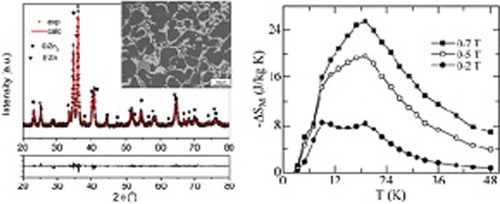
IMPACT STATEMENT
Table-like magnetocaloric effect (MCE) was realized in dual-phase ErZn2/ErZn composite, the MCE parameters are comparable or even larger than most of the reported materials, making ErZn2/ErZn composite attractive for magnetic refrigeration.
Nowadays, the interest of magnetic materials with giant/large magnetocaloric effect (MCE) has considerably grown because of their potential application for magnetic refrigeration (MR) [Citation1–17]. MCE can be characterized by the magnetic part of entropy change (ΔSM) in an isothermal process and the temperature change (ΔTad) in an adiabatic process when the magnetic field is applied or removed which is an intrinsic behaviour for all magnetic solids. The MR technology based on MCE is expected to replace the traditional gas compression/expansion refrigeration technology in near future due to its higher efficiency and more environmental friendly [Citation1–6]. The Ericsson cycle [Citation7,Citation8] which consists of two isothermal and two isomagnetic field processes is proposed to be the best cycle for MR technology. It is well known that the MR material should possess a constant ΔSM in a wide temperature range for an ideal Ericsson cycle. Thus, searching for or producing the MR materials that possess a table-like MCE in a wide temperature range is one of the most important requirements for active applications. This can be indirectly characterized by the parameter of refrigerant capacity (RC). For this purpose, series of rare earth (RE)-based alloys and compounds have been systematically studied recently with respect to the MCE properties. And, the table-like MCE have been realized in some of the magnetic materials that undergo multiple successive magnetic transitions or magnetic field-sensitive magnetic transition(s) as well as in some composite materials [Citation9–15].
Among the RE-based alloys and intermetallic compounds, the research related to RE with Zn, Mg, and Cd is not too much [Citation6]. This might be a consequence of the difficulty in sample preparation due to the low boiling point (high vapour pressure) of Zn, Mg, and Cd. Very recently, Li [Citation6] have reviewed the recent progress of MCE in the intermetallic compounds of RE with Zn, Mg, and Cd metals. Some of them process very excellent MCE properties. For examples, a table-like MCE from 20 to 160 K together with very large RC values were observed in Eu4PdMg [Citation13]. A giant low-field reversible MCE around 8 K was reported in TmZn which is related to the field-induced metamagnetic (first ordered) magnetic transition [Citation16], additionally, the MCE and metamagnetic transition in TmZn can be gradually suppressed by hydrostatic pressure [Citation17]. According to the phase diagram of ErZn system, the ErZn compound could co-exist with ErZn2 compound in a wide range [Citation18], thus, the structure, magnetic properties, and MCE in dual-phase ErZn2/ErZn composite were investigated in this letter, and a table-like MCE together with large RC was observed.
The dual-phase ErZn2/ErZn composite was synthesized by induction melting of the high-purity elements of Er and Zn in quartz crucible in a water-cooled sample chamber. Firstly, high-purity Er and Zn with nominal composition of Er40Zn60 were weighted and sealed in a quartz crucible which was filled with argon pressure of 78 kPa. Then, the quartz crucible was placed in a water-cooled sample chamber of an induction furnace and heated up to 1273 K for 3 min. To ensure the homogeneity, the ingot together with the quartz crucible was turned and melted for 4 times by open the chamber after each melting when the crucible was cooled to room temperature. The phase and composition were characterized by X-ray diffraction (XRD) technology (Rigaku RINT 2200) and the scanning electron microscope (SEM) with energy dispersive spectroscopy (EDS) attached (Hitachi SU70). The temperature and magnetic field dependence of magnetization measurements were performed by the vibrating sample magnetometer (VSM) which is an option of the physical property measurement system (Quantum Design PPMS-9).
shows the room temperature XRD pattern and the Rietveld refinement using MAUD program. The refinement reveals that the as-casted ingot mainly crystallizes in two phases, i.e., orthorhombic CeCu2 type ErZn2 phase belonging to the Imma space group and the cubic CsCl type ErZn phase belonging to the Pm3m space with the weight ratio of 53.8 : 46.2. The small peak around 28 degree which was marked by star in is related to the tiny amount impurity phase of Er2O3. The factors of Rietveld refinement which were calculated by MAUD software are RB (%) = 12.2 and Rexp (%) = 13.3. The refined lattice parameters a, b, and c for ErZn2 are 4.446(2), 6.991(4), and 7.591(5) Å, respectively, and the value of a for ErZn is 3.5284(3) Å. These values are well consistent with the values reported in the literature [Citation18]. The Back-scattered scanning electron (BSE) image of the dual-phase ErZn2/ErZn composite is shown in . The corresponding secondary electron (SE) image is also displayed in the inset of . Both BSD and SE images show similar behaviour, the microstructure obviously consists of two phases under both modes, i.e. dark and white phases (BSE image). By means of the EDS analysis, the dark phase is determined to be ErZn2 with the compositions of 33.1 at. % Er and 66.9 at. % Zn, whereas the white phase is determined to be ErZn with the compositions of 50.3 at. % Er and 49.7 at. % Zn. And, the overall composition of the ingot are 39.4 at.% Er and 60.6 at. % Zn.
Figure 1. Room temperature power X-ray diffraction pattern of dual-phase ErZn2/ErZn composite with the Rietveld refinement using MAUD program.
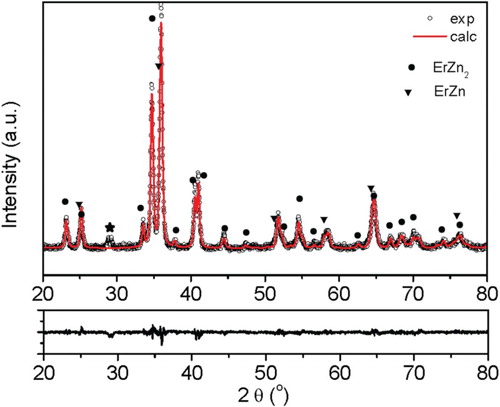
Figure 2. Back-scattered scanning electron (BSE) image of the dual-phase ErZn2/ErZn composite. Inset shows the corresponding secondary electron (SE) image of the dual-phase ErZn2/ErZn composite.
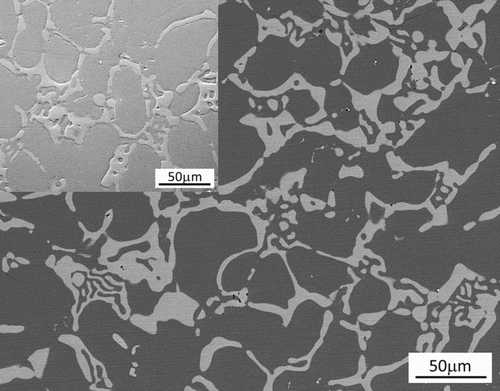
shows the temperature dependence of magnetization σ (left scale) and dσ FC/dT (right scale) for dual-phase ErZn2/ErZn composite under the magnetic field of B = 1 T, the inset shows the temperature dependence of magnetization σ under the zero field cooled (ZFC) and field cooled (FC) mode for dual-phase ErZn2/ErZn composite under B = 0.1 T. We can note that the dual-phase ErZn2/ErZn composite processes two successive magnetic phase transitions around 9 and 20 K (defined as the inflection point of the dσ/dT-T curve), which are believed to be corresponding to the transitions of ErZn2 [Citation19] and ErZn [Citation20] compounds, respectively. Additionally, only some small differences between the σ(T) curves measured in ZFC and FC mode for dual-phase ErZn2/ErZn composite can be observed at low temperature. Considering the low TC and large magnetic anisotropy for ErZn2 and ErZn compounds [Citation19,Citation20], the bifurcate behaviour between ZFC and FC curves for present dual-phase ErZn2/ErZn composite is due to the domain wall pinning effect where the width of domain wall is comparable with that of lattice spacing [Citation21]. A set of magnetic isotherms σ(B) for dual-phase ErZn2/ErZn composite up to 7 T with increasing and decreasing magnetic field were measured from 3 to 38 K to understand its MCE properties. Before collecting each σ(H) curve, the sample was heated up to 60 K, and then down to the measured temperature using ZFC mode. The temperature interval is 2 K from 4 to 34 K, and the increments of magnetic field are 0.1 T for 0–2 T and 0.25 T for 2–7 T, respectively. No obvious differences between increasing and decreasing magnetic field over the temperature range, i.e. no thermal and magnetic hysteresis can be observed for present dual-phase ErZn2/ErZn composite which is beneficial for active MR application. Several σ(B) curves for dual-phase ErZn2/ErZn composite with increasing magnetic field are presented in (a) for a clarify. A large reversible MCE for present dual-phase ErZn2/ErZn composite is expected since the magnetization is quite large and it changes rapidly with varying temperature.
Figure 3. Temperature dependence of magnetization σ (left scale) and dσ FC/dT (right scale) for dual-phase ErZn2/ErZn composite under the magnetic field of B = 1 T. The inset shows temperature dependence of σ under the zero field cooled (ZFC) and field cooled (FC) mode for dual-phase ErZn2/ErZn composite under B = 0.1 T.
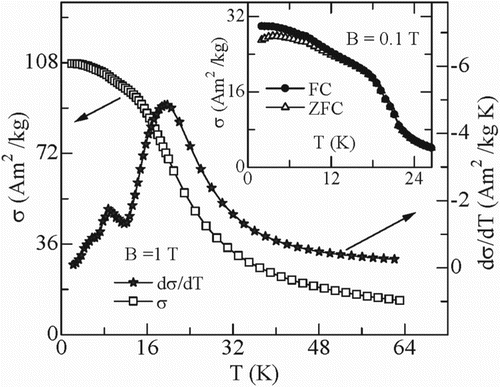
Figure 4. (a) Magnetic field (B, increasing only) dependence of the magnetization σ for dual-phase ErZn2/ErZn composite. (b) Temperature dependence of magnetic part of entropy change –ΔSM for dual-phase ErZn2/ErZn composite.
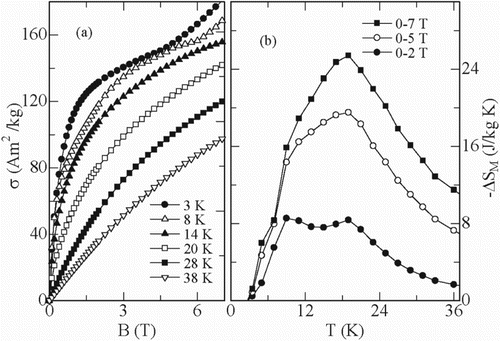
According to thermo-dynamical theory, the isothermal magnetic part of entropy changes associated with the magnetic field change is given by
(1)
From the Maxwell's thermodynamic relation:
(2)
we can obtain the following expression:
(3)
in which SM, σ, B, and T are the magnetic part of entropy, magnetization of the material, applied magnetic field intensity, and the temperature of the system, respectively. From the σ measured at discrete field and temperature intervals, ΔSM can be approximately calculated by the following expression:
(4)
The temperature dependence of isothermal magnetic part of entropy change –ΔSM(T) for dual-phase ErZn2/ErZn composite under different magnetic field changes (ΔB) of 0–2, 0–5, and 0–7 T which was calculated from σ(B, T) curves by using Equation (4) are given in (b). Two pronounced peaks (or shoulder) can be observed in the –ΔSM(T) curves around 10 and 20 K which are believed to be corresponded to the ErZn2 and ErZn, respectively. Two peaks overlap with each other and induced a broad table-like behaviour in the –ΔSM(T) curves, i.e. table-like MCE in dual-phase ErZn2/ErZn composite, which is beneficial for active MR application. With the magnetic field changes of 0–5 and 0–7 T, the maximum values of the magnetic part of entropy change
for dual-phase ErZn2/ErZn composite are 19.5 and 25.4 J/kg K, respectively, The value of
for dual-phase ErZn2/ErZn composite is comparable with that of recently reported large/giant MCE materials in the similar working temperature region, for examples, under ΔB of 0–5 T, the values of
are 19.1, 16, 17.3, 14.6, and 21.3 J/kg K for ErNiSi [Citation22], HoAgGa [Citation23], Tm2Cu2Cd [Citation14], HoPdIn [Citation24], and ErRuSi [Citation25], respectively, i.e., the present dual-phase ErZn2/ErZn composite is also belonging to the class of large MCE materials.
Another important quality factor of MR materials is the RC which is an indirect measurement of heat transfer in an ideal MR cycle between the cold and hot reservoirs. There are three different methods which are conventionally used to evaluate the values of RC from the ΔSM (T) curves: [Citation1,Citation6,Citation13] (1) calculated by integrating of the area under the ΔSM (T) curve by using the temperatures at full width at half maximum in the ΔSM (T) curve, δTFWHM (RC-1); (2) defined as the product of and δTFWHM (RC-2); and (3) by maximizing the product ΔSM and δT in the ΔSM (T) curve (RC-3) [Citation13]. The values of δTFWHM for dual-phase ErZn2/ErZn composite are 20.2, 22.9, and 25.4 K for the ΔB of 0–2, 0–5, and 0–7 T, respectively. The values of RC-1, RC-2, and RC-3 are evaluated to be 145, 172, and 96 J/kg for ΔH of 0–2 T, to be 362, 447, and 232 J/kg for ΔH of 0–5 T, and to be 503, 645, and 343 J/kg for ΔH of 0–7 T, respectively. Here, we use the values of RC-1 as the MCE figure-of-merit for comparison with other materials which were calculated in the same way. The magnetic transition temperature(s) TM together with the MCE parameters (
, δTFWHM, and RC-1) under ΔB of 0–5 T for dual-phase ErZn2/ErZn composite and some recently reported giant/large MCE materials below 30 K are listed in for comparison. We can note that the MCE parameters for present dual-phase ErZn2/ErZn composite are comparable or even obviously larger than these potential magnetic refrigerant materials in the similar temperature region indicate that the dual-phase ErZn2/ErZn composite could be a promising candidate for MR at low temperature.
Table 1. The magnetic transition temperature(s) TM together with the MCE parameters (–ΔSMmax, δTFWHM, and RC-1) under the magnetic field change of 0–5 T for dual-phase ErZn2/ErZn composite and some recently reported giant/large MCE materials below 30 K.
In summary, dual-phase ErZn2/ErZn composite with a table-like MCE was obtained by induction-melting method. The composite undergoes two successive magnetic phase transitions at 9 and 20 K which are corresponding to the phases of ErZn2 and ErZn, respectively, and resulting two peaks (or shoulder) in the temperature dependence of magnetic part of entropy change curves, ΔSM(T). The partly overlapping of these peaks induced a table-like MCE and large RC. And accordingly two peaks (partly overlapped) are appeared in the ΔSM(T) curves which resulting in a table-like MCE and large value of δTFWHM as well as large RC. For the ΔB of 0–7 T, the value of reaches 25.4 J/kg K, and the corresponding values of RC-1, RC-2, and RC-3 are 503, 645, and 363 J/kg, respectively. The observed large RC values and reversible table-like MCE make the presently reported dual-phase ErZn2/ErZn composite also attractive as refrigerant, especially for low-temperature MR. Moreover, the present results may also provide a workable way to producing table-like MCE materials with large values of RC.
Disclosure statement
No potential conflict of interest was reported by the authors.
Additional information
Funding
References
- Gschneidner KA Jr, Pecharsky VK, Tsokol AO. Recent developments in magnetocaloric materials. Rep Prog Phys. 2005;68:1479–1539. doi: 10.1088/0034-4885/68/6/R04
- Shen BG, Sun JR, Hu FX, et al. Recent progress in exploring magnetocaloric materials. Adv Mater. 2009;21:4545–4564. doi: 10.1002/adma.200901072
- Moya X, Defay E, Heine V, et al. Too cool to work. Nature Phys. 2015;11:202–205. doi: 10.1038/nphys3271
- Franco V, Blazquez JS, Ingale B, et al. The magnetocaloric effect and magnetic refrigeration near room temperature: materials and models. Ann Rev Mater Res. 2012;42:305–342. doi: 10.1146/annurev-matsci-062910-100356
- Manosa L, Planes A, Acet M. Advanced materials for solid-state refrigeration. J Mater Chem A. 2013;1:4925–4936. doi: 10.1039/c3ta01289a
- Li L-W. Review of magnetic properties and magnetocaloric effect in the intermetallic compounds of rare earth with low boiling point metals. Chin Phys B. 2016;25:037502. doi: 10.1088/1674-1056/25/3/037502
- Zimm C, Jastrab A, Sternberg A, et al. Description and performance of a near-room temperature magnetic refrigerator. Adv Cryogen Eng. 1998;43:1759–1766. doi: 10.1007/978-1-4757-9047-4_222
- Smali A, Chahine R. Composite materials for Ericsson-like magnetic refrigeration cycle. J Appl Phys. 1997;81:824–829. doi: 10.1063/1.364166
- Zhang Y, Hou L, Ren Z, et al. Magnetic properties and magnetocaloric effect in TmZnAl and TmAgAl compounds. J Alloys Compd. 2016;656:635–639. doi: 10.1016/j.jallcom.2015.10.026
- Zhang YK, Guo D, Yang Y, et al. Magnetism and magnetocaloric effect in the RE2CuSi3 (RE = Dy and Ho) compounds. J Alloys Compd. 2017;702:546–550. doi: 10.1016/j.jallcom.2017.01.285
- Yi YL, Li LW, Su KP, et al. Large magnetocaloric effect in a wide temperature range induced by two successive magnetic phase transitions in Ho2Cu2Cd compound. Intermetallics 2017;80:22–25. doi: 10.1016/j.intermet.2016.10.005
- Yang Y, Zhang YK, Xu X, et al. Magnetic and magnetocaloric properties of the ternary cadmium based intermetallic compounds of Gd2Cu2Cd and Er2Cu2Cd. J Alloys Compd. 2017;692:665–669. doi: 10.1016/j.jallcom.2016.09.104
- Li L, Niehaus O, Kersting M, et al. Reversible table-like magnetocaloric effect in Eu4PdMg over a very large temperature span. Appl Phys Lett. 2014;104:092416. doi: 10.1063/1.4867882
- Zhang YK, Yang Y, Xu X, et al. Large reversible magnetocaloric effect in RE2Cu2In (RE = Er and Tm) and enhanced refrigerant capacity in its composite materials. J Phys D: Appl Phys. 2016;49:145002. doi: 10.1088/0022-3727/49/14/145002
- Li G, Wang J, Cheng Z, et al. Large entropy change accompanying two successive magnetic phase transitions in TbMn2Si2 for magnetic refrigeration. Appl Phys Lett. 2015;106:182405. doi: 10.1063/1.4919895
- Li LW, Yuan Y, Zhang Y, et al. Giant low field magnetocaloric effect and field-induced metamagnetic transition in TmZn. Appl Phys Lett. 2015;107:132401. doi: 10.1063/1.4932058
- Li LW, Hu GH, Qi Y, et al. Hydrostatic pressure effect on magnetic phase transition and magnetocaloric effect of metamagnetic TmZn compound. Sci Rep. 2017;7:42908. doi: 10.1038/srep42908
- Zhu ZJ, Pelton AD. Critical assessment and optimization of phase diagrams and thermodynamic properties of RE-Zn systems-part II- Y-Zn, Eu-Zn, Gd-Zn, Tb-Zn, Dy-Zn, Ho-Zn, Er-Zn, Tm-Zn, Yb-Zn and Lu-Zn. J Alloys Compd. 2015;641:261–271. doi: 10.1016/j.jallcom.2015.02.227
- Kitai T. Anisotropic magnetic susceptibility and crystal field effect of RZn2 (R = Tb, Dy, Ho and Er). J Phys Soc Jpn. 1995;64:3403–3408. doi: 10.1143/JPSJ.64.3403
- Morin P, Pierre J. Magnetocrystalline anisotropy of equiatomic rare earth-zinc compounds: DyZn and ErZn. Phys Status Solidi A. 1973;17:479–482. doi: 10.1002/pssa.2210170211
- Buschow KHJ. Intermetallic compounds of rare-earth and 3d transition metals. Rep Prog Phys. 1997;40:1179–1256. doi: 10.1088/0034-4885/40/10/002
- Gupta S, Rawat R, Duresh KG. Large field-induced magnetocaloric effect and magnetoresistance in ErNiSi. Appl Phys Lett. 2014;105:012403. doi: 10.1063/1.4887336
- da Silva LM, dos Santos AO, Coelho AA, et al. Magnetic properties and magnetocaloric effect of the HoAgGa compound. Appl Phys Lett. 2013;103:162413. doi: 10.1063/1.4826440
- Li L, Namiki T, Huo D, et al. Two successive magnetic transitions induced large refrigerant capacity in HoPdIn compound. Appl Phys Lett. 2013;103:222405. doi: 10.1063/1.4834815
- Gupta S, Duresh KG. Giant low field magnetocaloric effect in soft ferromagnetic ErRuSi. Appl Phys Lett. 2013;102:022408. doi: 10.1063/1.4775690
- Li L, Nishimura K, Hutchison WD, et al. Giant reversible magnetocaloric effect in ErMn2Si2 compound with a second order magnetic phase transition. Appl Phys Lett. 2012;100:152403. doi: 10.1063/1.4704155
- Samanta T, Das I, Banerjee S. Giant magnetocaloric effect in antiferromagnetic ErRu2Si2 compound. Appl Phys Lett. 2007;91:152506. doi: 10.1063/1.2798594
- Li LW, Nishimura K. Giant reversible magnetocaloric effect in antiferromagnetic superconductor Dy0.9Tm0.1Ni2B2C compound. Appl Phys Lett. 2009;95:132505. doi: 10.1063/1.3240399
- Dong QY, Chen J, Shen J, et al. Magnetic properties and magnetocaloric effects in R3Ni2 (R = Ho and Er) compounds. Appl Phys Lett. 2011;99:132504. doi: 10.1063/1.3643142
- Li L, Nishimura K, Yamane H. Giant reversible magnetocaloric effect in antiferromagnetic GdCo2B2 compound. Appl Phys Lett. 2009;94:102509. doi: 10.1063/1.3095660
